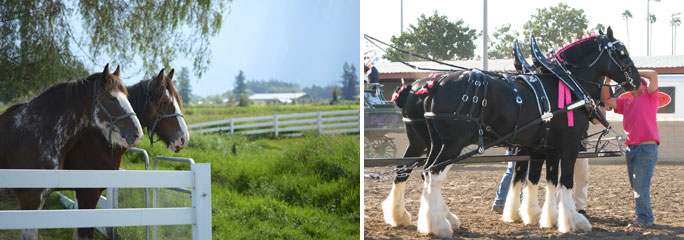Unique Aspects of an Already-Unique Breed
Since the repeal of Prohibition, Clydesdale horses have become synonymous with Budweiser beer. The flamboyant draft horse is featured in national advertising, parades and horse shows. But the humble beginnings of the breed were on the farm. And although Clydesdales were replaced by tractors in many places, they are still plowing and planting today.
Sixty-one-year-old Dennis Rud has a team of eight Clydesdales he uses to plow and plant oats, haul manure and rake hay and straw on his farm near Decorah, Iowa. “It’s fun being out there,” says Rud, who uses a tractor for corn and soy beans. “You can hear the birds.”
In the early 1800s, the Clydesdale was bred as a workhorse in Lanarkshire, Scotland, formerly known as Clydesdale, according to Clydesdale Breeders of the U.S.A., a 134-year-old Pecatonica, Ill.-based group. It was perfect for the soft Scottish turf while being well suited for Lanarkshire coalfields and hauling on Glasglow streets.
But the machine age left many Clydesdale without farm jobs. Don Castagnasso, an 88-year-old Clydesdale owner from the Ocala area, still remembers when his family used Clydesdales to raise oats, barley and wheat in Sonoma, Calif. “That was pre-tractor days,” he says. “At the time it was the best we had.”
He says the Clydesdales are better at hauling light loads that require more speed than power. “They’re quite intelligent. You don’t outmuscle them. You have to outthink them,” observes Castagnasso, former president and board member of Clydesdale Breeders.
Here are some lesser-known facts about the Clydesdales:
• A Clydesdale’s horseshoe is close to the size of a dinner plate, according to the Clydesdale Breeders group, and it weighs about five pounds.
• The Clydesdale lacks the umph of some of the other horse breeds, says Carol Angelbeck, a 75-year-old Clydesdale owner from Ocala. She says owners should stay with foals when they are being born to help them. “They’re the most gentle animals you’ll ever ever meet,” she points out. “They’re so docile, so laid back, so mellow … You have to really pay attention to them.”
• “They don’t eat near as much as a thoroughbred because their metabolism is so slow,” Angelbeck says.
• Although they were bred for hard labor, they’re actually better show horses, Castagnasso says. “They’re flashier and don’t have the power and stamina that some of the other draft breeds do,” he explains.
• The Clydesdales are capable of having twins that survive, which is pretty unusual, Castagnasso observes.
• Clydesdales actually are similar looking to the Shires, he adds.
• The hair on the Clydesdales’ legs, known as feathers, requires special care. Rud uses oil to remove cockleburs in the fall. Sometimes they get sores.
• Florida’s climate is not ideal for the Clydesdales, which prefer cooler and drier weather, Angelbeck says.
• “You’re not going to make money raising and showing Clydesdales,” Castagnasso states.
• Clydesdales can pull double duty as a farm horse and show horse. Helping on the farm makes them stronger for the shows, Rud says. “It’s kind of like practicing for a ball game.”
Castagnasso got his first Clydesdale when he was eight, 80 years ago, and has owned them ever since. “I guess everybody has to like something. I happen to like Clydesdale horses. I enjoy them. As we say in our family, it’s a disease that there’s no cure for.”
CREDIT
story by CHERYL ROGERS

